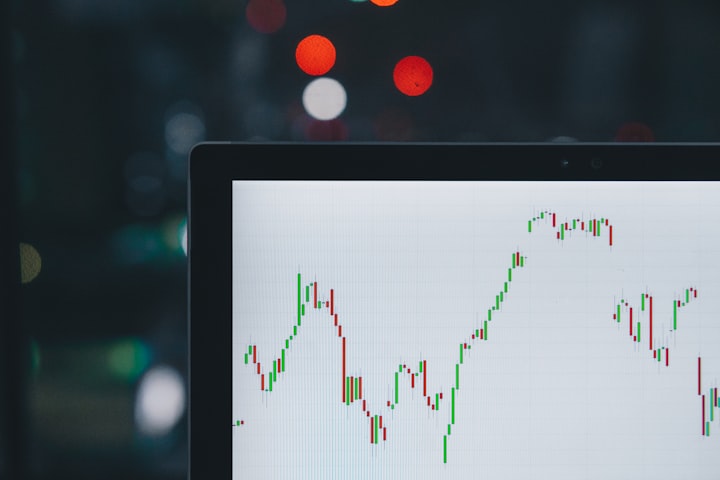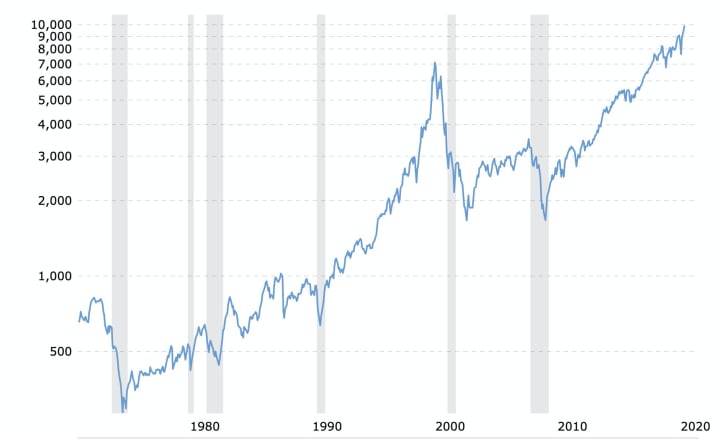Pushing Towards New Highs
Jerrick is on the launch pad for uplisting, ready for ignition, and writing a new chapter in the story of technology in the capital markets.

I had a front-row seat at the birth of electronic trading, and it had a profound influence on my career and the thought processes that I would systematically apply to all subsequent endeavors. At first, I was simply enthralled by what we were able to do with the data; how we assessed it and took risk in order to generate more money, with which we could take more risk. I became fascinated by the power and control a trader wielded when relying on data to make decisions. It was years later before I began thinking about the bigger picture and the implications of this new kind of trading. It’s a story about how technology systematically changed a well over 200-year-old industry.
Buy, Buy, Buy; Sell, Sell, Sell

The algorithmic traders buy, buy, buy until the market data tells them otherwise. Quantitative programs trade the market, taking advantage of behavioral analysis and predictability. Then they sell, sell, sell until their programs tell them otherwise. Then they process data, adjust inputs, and repeat.
Trading algorithms operate with the objective to make the most money at the extreme. Therefore, it is in their interest to see extremes met in the most efficient way possible, and as often as possible. And if that means buying until the extreme and then selling with the same sheer force, they will.
Undoubtedly, financial market data helps generate alpha, and hopefully a profit, for traders and institutions, but it’s often at the expense of some portion of the retail or individual investor community. In the end, when bubbles inevitably burst, unsophisticated investors are the last ones buying or selling. More often than not it’s the investors from and employees of the lower socioeconomic classes that sustain the most damage because they often lack data and resources to help inform their decisions. It stands to reason that in the middle of a pandemic, a divisive election, and a great social awakening I referred to as the American Spring, the safest type of investments are companies like JMDA, that own and operate scalable, sustainable, and defendable technology platforms.
Jerrick’s technology platform, Vocal, processes data, identifies inefficiencies and lowers our acquisition costs for creators as well as audience acquisition costs for brands. We then run the adjusted strategies, collect more data, and repeat. In this way, both success and failure define the next success, as we are simply eliminating inputs that failed and increasing and expanding upon the ones that succeeded. This strategy deeply manifests itself in almost every aspect of JMDA’s business model.
Party Like It’s 1999
The year was 1999. Cher was at the top of the charts with “Believe,” an appropriate anthem for the year, and Who Wants to be a Millionaire was the top-rated show; the answer was everyone. Consumer technology went mainstream that year, as Research in Motion (RIM) released the Blackberry and the TiVo was introduced at CES.
All in all, 1999 proved to be a great year for the market. That year alone was responsible for 25% of the total gains the Dow Jones had experienced since its inception. Meanwhile, the NASDAQ rose a colossal 85%, while the S&P rose 20%–that being the fifth straight year of double-digit growth for the S&P. To put the pace of market growth in the late ‘90s into perspective: Today, the NYSE trades nearly 4 billion shares a day, that being nearly 4x what it did in 1999. 133 years ago, daily trading volume on the New York Stock Exchange topped 1 million for the 1st time ever. More than anything, these growth patterns underscore the fact that traders gain a significant edge over the rest of the market as data and volume increase hand in hand.
In total, 1999 saw a record 203.9 billion and 265.6 billion shares traded on the New York Stock Exchange and the NASDAQ, respectively, putting to rest any uncertainty that the future would lie in technology and electronic trading.
The Rise of Tech Dominance
During the mid-’90s, the S&P had begun to show amazing movement, a fact which general consensus attributed almost entirely to tech, for both its effect on trading processes themselves and the actual tech stocks being traded. First, the advent of tech, and its introduction to the trading floor, made trading fundamentally cheaper and more efficient. This had the follow-on effect of making people want to trade more, which itself begot only more trading. The other major effect was that, before long, commissions went from dollars to zero. It was the beginning of the end of commissions (‘easy money’) on Wall Street and the birth of algorithmic data-based trading (or, ‘sophisticated money’). What followed was a slew of new companies and the birth of a whole new industry, which bore the promise of many more great ideas to come in the financial technology space. It was nothing short of revolutionary.
Until the information age, a trader’s alpha was limited. But the ability to quantitatively analyze data at the depths and speeds that new technology offered made legacy analysis obsolete in less than 10 years. Financial technology services would eventually become one of the country's most valuable exports, along with general innovation. The idea of utilizing data overtook the world of Wall Street at the turn of the century. Then came the first exogenous event of the 21st century. Exogenous events, often black swans, rapidly cause systemic changes that are best studied in hindsight. Today’s market bubble is unlike anything we have seen because it dwarfs the fundamental problems created by the first two crises of the 21st century.

Early ‘00s: Market Meltdown
The horror of 9/11 reversed decades of growth in the market. In 2003, the Dow bottomed out near 7,800 (it had last been there in late-1997), marking the end of the first bubble of the new millennium. The market did not return to its previous 11,500 high until October of 2006, three years later. Between October 2006 and October 2007, the market finally climbed to 14,000. Easy money and aggressive risk created bubbles in several financial markets, and the world was not prepared for the level of greed and leverage that had infected the financial space. These factors ultimately resulted in the second exogenous event of the 21st century, one that would impact the world deeply and systemically.
The globalization of economies arguably created an impact more pronounced than even the economic damage from the 9/11 terrorist attack. The damage was so severe that the market did not bottom out until March of 2009, at 6,800 (it had last been there in early 1997), and that was another 1,000 points lower than its low in 2003. The Dow would not find its way back to the 11,400 level that it began the century with until years later in January of 2011, post the 2008 financial crisis.
The events of this decade all boil down to this: the stock market went nowhere for the first 10 years of this century and withstood two exogenous crises followed by systemic financial fallout.
‘Too Big to Fail’ and Systemic Risk
In 2008, the only way to save the country from a depression was to provide a government-sponsored financial bailout that helped create the “too big to fail” mentality (a euphemism for bubble). In fact, “too big to fail” has spread far and wide beyond the financial services and insurance businesses. Globalization has created a series of companies that are too big to fail, from the airlines and cruise ship industry to banking and technology infrastructures. This backstop mentality came with $2.8 trillion injected into the economy by the government over the course of three years. The plan back then was to restart the economy by incentivizing hiring within corporate America. (Eventually, it worked. Starting in late 2010, the Dow Jones went on a five-year run to nearly 19,000 before the election of Donald Trump.)
While all this was going on, I myself left Wall Street in 2010 and began a career in the technology space. My first attempt at building a tech company took less than 15 months to fail, and turned out to be a spectacularly humbling experience. I would venture as far as to say that this particular failure changed the trajectory of my life and my perspective on the world, and led me to envision JMDA and our flagship product, Vocal.
As an outsider, looking into my old world of Wall Street, I am both frustrated that I missed the greatest bull market run ever and very concerned over the policies of both the Obama and Trump administrations. They did and do everything they could to continue an easy money policy and a too-big-to-fail mentality, seemingly at any cost.
One such cost would be a historical widening of the socioeconomic gap and its impact on the American people. Until recently, the great divide was still obscured from the reality of day-to-day life. That social bubble is bursting as we speak. Unemployment was another big bubble that we all refused to face. It isn’t solved by the stimulus, it is solved by education and reformation of the workforce ideology. Saving legacy jobs at the expense of training for the future was a fundamentally bad decision by the last few administrations.
Companies kept hiring and consumers kept buying without ever thinking it could come to an end. In spite of technology making many jobs irrelevant or obsolete, and the growing divide between politics, science, and the social classes, the unemployment level defied the odds and touched an extreme low of 3.5% just prior to the pandemic.
Pre-Trump, from 2000 to 2016, the market essentially rose by 65%. In just a three year period, the market rose by nearly 55% from January 2017 to March 2020. But it was a fragile run, grounded less in fundamentals than in wishful thinking and cheerleading. This next decade will have a very different feel to it.
The stock market has recovered nearly all of its losses from its March 2020 lows. If the last 20 years of behavior is predictive, we may very well be in a highly over-extended valuation period for the broad stock market. It would not surprise me to see the market not only retest the lows of March but potentially break below it. At a minimum, as the data indicates, there is a winding and very long road ahead to economic recovery.
Like the market, the digital space is also a combination of human curation and moderation complemented by machine learning algorithms. This combination is what creates the elasticity in the market and margins in the digital space. It leads to extreme movements between fear and euphoria in the stock market, as well as contracting and widening transactional spreads on technology platforms. The current extreme, one that makes ‘hanging chads’ seem silly, may create the conditions for the type of real change it will take to repair what will be years of damage to the economy and our social fabric.
Jerrick On The Launchpad
On July 8th, we held our first-ever shareholder meeting. This was a monumental moment for our company, being both an inaugural event as well as one of the last opportunities for us to address our entire network before we complete our uplisting to the Nasdaq Capital Markets. I wanted to once again thank the team who worked so hard to put the meeting together. It was their collective effort that not only made this virtual shareholder meeting such a success, but established a baseline and foundation for us to make the next one even better.
The reality is that even when a company faces the optimal conditions–which I and many others are convincved is the case with Jerrick–achieving an uplisting is no small feat. In fact, Jerrick will be one of only about six companies that have successfully uplisted this year.
The below data puts into perspective the enormity of this undertaking:
• In 2019, there were 159 initial public offerings (IPOs) in the United States. This was half as many as there were 20 years ago when the dotcom bubble was forming.
• The number of public companies in the US has been on a steady decline since peaking in the late 1990s.
• 3,000+ companies are listed on the NASDAQ.
• 10,000+ entrepreneurial companies are listed on the OTCQB.
• Over the last decade, an average of 25 and 75 companies a year have uplisted from the OTCQB to the NASDAQ.
• There are nearly 6,000+ companies with a market cap above $1 billion in the US public markets.
• In the startup world, the odds of a company achieving a valuation of $1 billion or more is considered so slim, it's named after a mythical beast—the unicorn.
In late 2013, as I was bouncing back from some of the most difficult—let alone humbling—years of my life, I began to find purpose and direction. Like the incomprehensible power of data itself, my vision was audacious and a top-down approach ideologically with a bottom-up approach operationally. Rather than explain what I wanted to build, I explained to investors what I wanted it to be worth. I wanted to build a billion-dollar company and, to keep things unambiguous, I wanted to do it in the public markets. This way transparency would be unquestionable, both in my actions as well as in our valuation.
Having sold Carlin Financial for $100MM in 2008 to the Royal Bank of Canada, then spending a tumultuous period there watching legendary firms like Bear Stearns, Lehman Brothers, and Merrill Lynch go out of business on top of a complete reversal on strategy at the bank itself, I was exhausted.
During my recovery period, in which I began to reevaluate my own passions, the most prevalent discovery that I made was that I was more of a creative person than I had given myself credit for being. In fact, it was during an early 2014 deep dive into the art world that I was introduced to my partner and President of Jerrick, Justin Maury. He introduced me to the notion that, in one way or another, we were all creators, and together we created Vocal. More interestingly, I discovered that I was no longer driven to success by the lure of money alone. Don't get me wrong, I want to make lots of money, but having sort of done it ('lots of money' is very subjective), I no longer fear not doing it. The loss of fear allowed me to fully express myself. Most importantly, it allowed me to again believe in myself as I did in the early ‘90s, before my 20-year journey on Wall Street. It’s why I proceeded to invest nearly every dollar I had into the ideas that Justin, myself, and our management team could imagine. Once we envisioned the collective, I became convinced that we could build the billion-dollar company I yearned to create.
As I mentioned in my last communication, we are on the launchpad for uplisting, and ready for ignition. I hope you will watch (or re-watch) the shareholder meeting, the recording of which is viewable in the above video, and the written transcript of which is available in the meeting recap. In addition, a recap of the meeting and analysis of the company has recently been independently published on Seeking Alpha.
For those in our network that watched the presentation live–an audience comprising shareholders, Vocal creators, prospective investors, press, and analysts–you already know that our strong technology is at the center of our growth strategy–it’s what enables us to continuously increase margins, leverage the organic value of our tech, and integrate acquisition targets like we do. But be that as it may, it is the unity and shared passion of Jerrick’s team that is ultimately responsible for scaling revenues and by extension, the company as a whole.
I look forward to continuing these regular updates as we complete the final stages of the uplisting and embark on Jerrick's exciting new chapter as what will be a newly rebranded Creatd, Inc., and continue to grow the ecosystem, network, and individual communities we as a company are committed to.
Stay safe, stay healthy and stay in touch.
Jerrick
LinkedIn: https://www.linkedin.com/company/jerrick-media
Twitter: https://twitter.com/JerrickMedia
Facebook: https://www.facebook.com/JerrickMedia/
Vocal
Instagram: https://www.instagram.com/vocal_creators/
Facebook: https://www.facebook.com/VocalCreators/
Twitter: https://twitter.com/Vocal_Creators
LinkedIn: https://www.linkedin.com/company/vocal
About the Creator
Jeremy Frommer
Chairman & Co-Founder of Creatd ($CRTD) and Vocal. We have much work to do together.






Comments
There are no comments for this story
Be the first to respond and start the conversation.